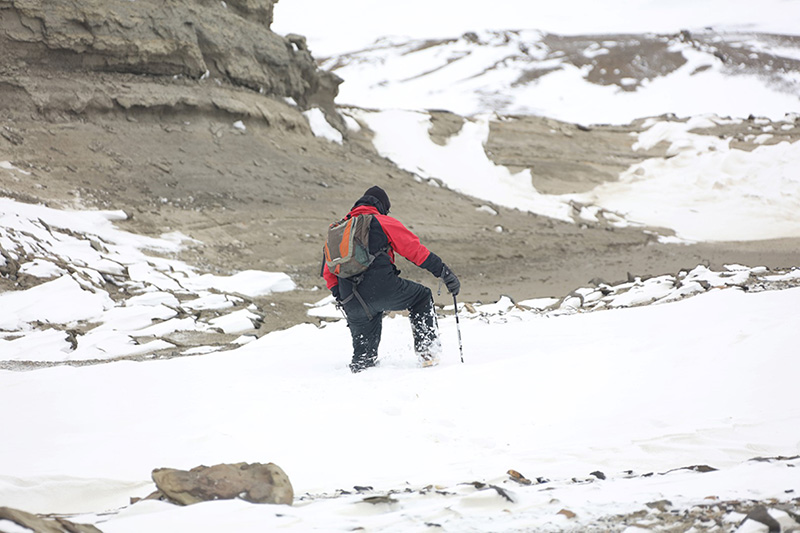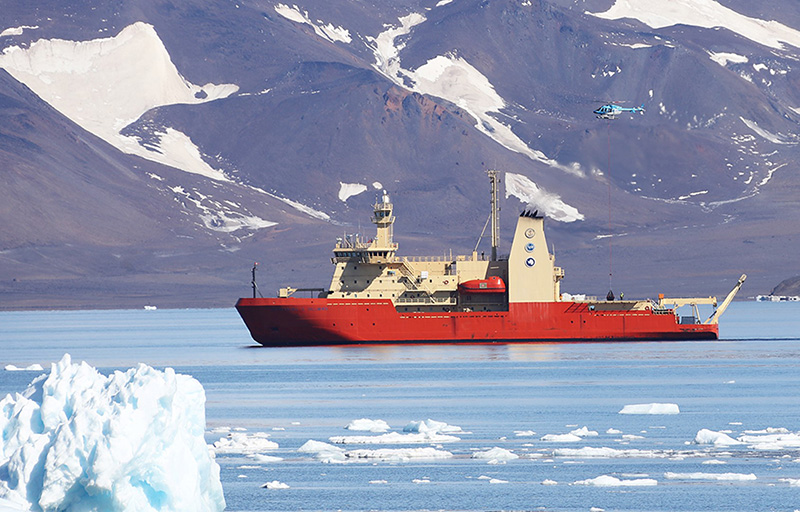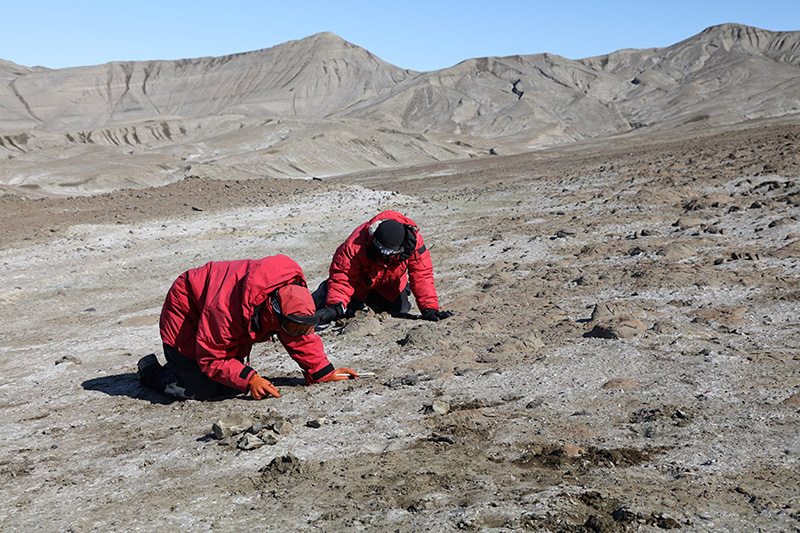Fossils and Geologic Data Hint at Ancient Antarctic Ecosystems (cont.)Posted May 25, 2016
McPhee wants to see how these groups of ancient mammals proliferated when the southern continents were still fused together in one giant supercontinent known as Gondwana. The current theory is that ancient marsupials flourished in the southern part of South America, then used Antarctica as a stepping stone before reaching Australia where they’re still prevalent today. A related theory states that another group known as Xenarthra, the ancestors of modern sloths, armadillos and anteaters, likely followed a reverse route, leaving Africa through Antarctica before reaching South America. 
Photo Credit: Meng Jin
The islands around James Ross Island were picked because they were formed around between about 40 and 70 million years ago, and their relative lack of snow.
“It’s a very nice story but if you want to be scientific about it, you’ve got to be empirical, which means that we need the fossils,” MacPhee said. “What we were doing was hoping that we would find fossils of either of these groups, optimally both of them.” Unfortunately, the only mammal fossils found during the expedition were some teeth from a far later period, around 40 to 50 million years ago. This is MacPhee’s sixth expedition to the continent and he has yet to find the kind of fossils that would be definitive proof of the paths these creatures took. “There is really no other way to explain their distribution,” MacPhee said. “In this line of work you have to be very persistent, you can’t just give it one shot and say that you’ve done the job.” This dearth of fossils is largely because the region was once a shallow sea, not the natural habitat for these kinds of land mammals, and any remains would have had to be washed out to sea. MacPhee said that even though this was likely his last Antarctic expedition, he’s confident that someday someone will find the fossils that would fill in the gaps. Always it’s exciting when you can find something that’s a new species, but when you get a lot of specimens, you can actually start to describe the ecology and the communities that are going on. Kerin Claeson “One of these days some graduate student will kick over a rock and there it will be,” MacPhee said. “It’s serendipitous when the fossils are as rare as what we’re talking about.” The actual process of fossil hunting can be slow and tedious, and it relies a fair bit on chance. First, scientists have to identify a region with rocks that look like they’re made of ancient sediment. Then, they start examining the terrain. “You’re basically walking along with your eyes on the ground, sometimes crawling along with your eyes on the ground, looking for fossils that have weathered out of the rock,” Lamanna said. If the paleontologist is lucky, they might recognize a small piece of bone or tooth sticking out of the surrounding rock. “It sounds kind of low tech, but it turns out human eyeballs are really great at detecting subtle patterns in the surface of these rocky outcrops and detecting the slight hint of different color or shape that would indicate that this is a biological remain rather than just another rock fragment,” said Julia Clarke, a professor of paleontology at the University of Texas at Austin. This season, the fossil hunters got a technological boost of sorts. To help transport scientists from ship to shore, the research vessel Nathaniel B. Palmer was specifically equipped with helicopters, in addition to its usual complement of small inflatable boats called Zodiacs. “We were basically able to use a double-pronged approach for almost the entirety of our most recently completed field season,” O’Connor said. “We were running concurrent operations on helicopters and Zodiacs.” 
Photo Credit: Meng Jin
The research vessel Nathaniel B. Palmer transported the scientists from Chile to the tip of the Antarctic Peninsula.
The researchers said it made a big difference over previous expeditions. “It’s not even a comparison,” O’Connor said. “There was so much we weren’t able to do in 2009.” On an earlier expedition to the region in 2009, heavy sea ice blocked the teams from landing at a number of locations they had hoped to explore. More seriously, trips planned for 2013 and 2014 had to be canceled because the ice was so extensive that there was no way for the Zodiacs to reach shore. “The helicopters negated the sea ice problem, they let us get to places we normally wouldn’t get to, they made even accessing the sites that historically we’ve worked at a lot easier,” Lamanna said. “It saved us tons of time. Time we’re not spending hiking up the mountain is time we can spend hunting for fossils.” What had been hour-long treks uphill to search for specimens in previous years turned into quick helicopter trips. The teams were also able to gather more specimens with the added mechanized help. “Having the helos, we were able to conserve energy for actually looking for fossils,” Clarke said. “Part of our team extracted part of a large marine reptile, and that just would not have been able to be done without this helo support.” That fossil, along with the fish specimens and hundreds of other samples the team collected, will be carefully analyzed and preserved once they reach the United States. After they arrive at their respective destinations, technicians will start removing excess rock from the bones as the science team members and their collaborators study the evolutionary relationships between the species. Ultimately, Carnegie Museum of Natural History will host the collected fossils for other researchers to access. “We’re going to be studying the more important fossils as we go along, so we’ll be able to dole out at least snippets of information along the way before the whole job is finished,” Lamanna said. “To fully prepare and curate the whole collection from this season is going to take years, for sure.” NSF-funded research in this story: Matt Lamanna, Carnegie Museum of Natural History, Award No. 1142129 |
"News about the USAP, the Ice, and the People"



For USAP Participants |
For The Public |
For Researchers and EducatorsContact UsU.S. National Science FoundationOffice of Polar Programs Geosciences Directorate 2415 Eisenhower Avenue, Suite W7100 Alexandria, VA 22314 Sign up for the NSF Office of Polar Programs newsletter and events. Feedback Form |


